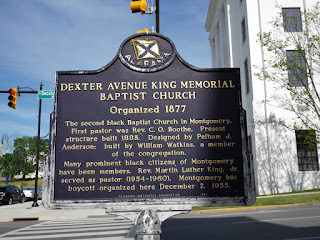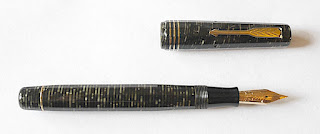At their best, these trips seem to develop their own theme. The
Southwest was native American culture. Last year’s trip was so extensive that
we did not find a theme. And we did not set out on this journey with a theme. Maybe
this theme was inevitable and maybe it found us in a Memphis hotel, but we seem
to be following Civil Rights as a theme. As I said, it may have been
inevitable.
So on Monday, we set ourselves a pretty hectic pace. The
goal was to visit Tuskeegee, to see both the university founded by Booker T.
Washington and to see the school’s Moton Field where the Tuskeegee Airmen were
trained.
 |
| The Student Union and other buildings ranged around the Quad. For some reason this campus quadrangle is not rated among the most beautiful in America. It should be. |
 |
| We were prepared for Tuskeegee University to tell the inspiring story of higher education for African-Americans in the late 19th century. We were not prepared for this isolated campus to be as beautiful as it is. |
 |
| The full story of the Tuskeegee Airmen is a remarkably inspiring story of young men who fought for true American values, both against foreign enemies and at home |
 |
| The signature P51 "Red Tails." As a footnote for you pen folk, Parker would, in advertising, pair the P51 Mustang fighter with its "51" pen. The Tuskeegee fliers protected the heavy bombers |
From there we went to Montgomery, scene of the 1955 bus
boycott, and to see the highly regarded Rosa
Parks Museum. The museum does not allow photography, but includes tons of
exhibits that are not only interactive but project you into the events, and is a definite “E” ticket (for those of
you old enough to remember them).
 |
| The entry to the museum |
 |
| This was Dr. King's first pulpit after he finished seminary |
And, finally, I particularly wanted to visit
Selma, where in 1965, at the Edmund Pettis Bridge, lawmen tried to stop voting
rights demonstrators from reaching Montgomery.
 |
| The Edmund Pettis Bridge seen from the West side as the marchers approached it. What they did not see were lawmen massed on the other side of the bridge with clubs and dogs. |
 |
| Today on the East side of the bridge there are memorials and tributes to the greats and the martyrs of the movement as well as a place for quiet thought and meditation and a walk along the river. |
Not so much the original bus boycott, which occurred when I
was a child, but the civil rights marches of the 1960s, were part of my
consciousness as a young man in high school and college and helped shape me.
Finally, one story, if I may:
Back at St. Peter’s parish, where we stopped and chatted
with some church people, I first heard the farewell, “Be Careful.” I did not
understand it. I thought it referred to highways, and speed traps, but since
then I have heard it from several African-Americans as we have parted. And as I
have come to understand it, it is a sort of verbal talisman. Maybe even a
warning about outsiders in the backwoods south.
Monday, as we were driving back along Highway 22 from Selma
to Birmingham (along the route taken by the marchers). I passed a red pick-up
truck traveling just under the speed limit. I did so responsibly using the
BMW’s power to very quickly get around the truck and back into my lane but by
the time I returned to my lane my speed was briefly in triple digits before I dropped
down to about 80 on the way back down to 70. The driver of that red pick-up
apparently did not like my show of speed and began following me closely. I took
it up to 95 and he stayed with me. I dropped to 85 while thinking about
strategies for not having something bad happen. Then, after a few miles he
resumed his speed of about 60 and fell back. In the middle of this Sharon’s
question was, “Where was Deliverance
set?” This morning on the news we heard of a backroads shooting on the highway.
Be Careful.























Comments